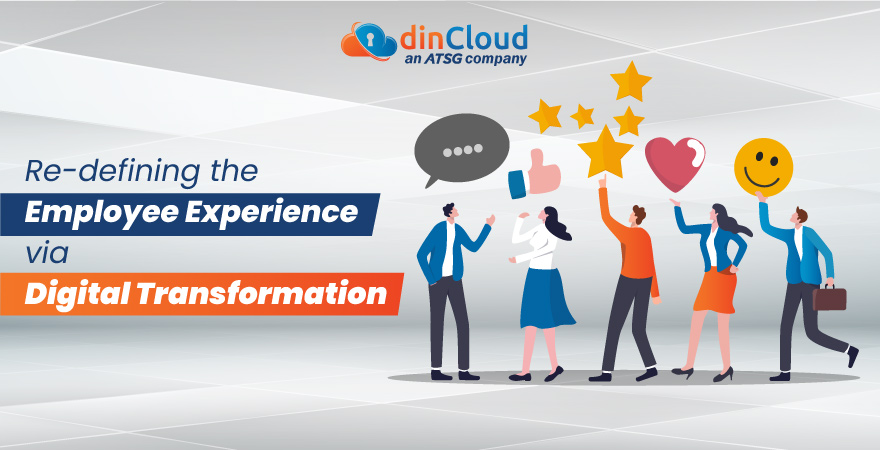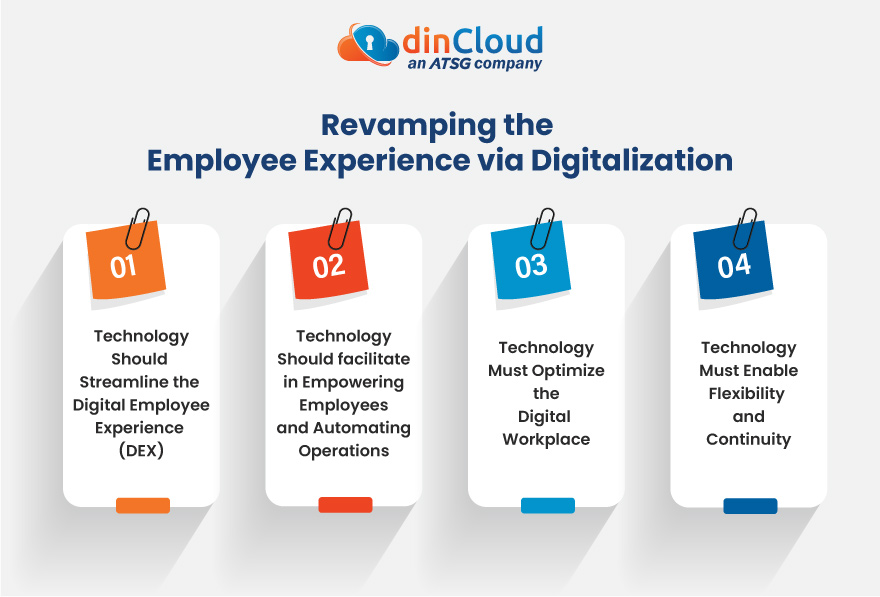Long before the global pandemic, numerous businesses had been talking about improving the overall work experience for all their employees. However, the extraordinary events of the year 2020 propelled employee experience to the top of enterprise-level priorities.
Today, if we take a look at any business’s workforce, it usually comprises tens, hundreds, or even thousands of employees, having unique needs, circumstances, and preferences. Some might be single parents, who prefer to work from home (WFH), while others might be keen on heading back to offices. Having deeper insights into each employee’s unique preferences will help businesses deliver a positive work culture that results in more productivity.

Businesses must seize this opportunity, and develop effective digital transformation strategies to convert their investments and efforts into a superior Digital Employee Experience (DEX).
The Urgency to Improve Digital Transformation Strategies
Jean-Philippe Courtois, the Executive Vice President at Microsoft, said that it is high time for businesses to inculcate effective digital strategies in their overall corporate agenda. However, in the rush to “go all digital”, businesses must not forget to prioritize the employee experience.
Research suggests that only 8% of businesses are completely satisfied with their current business paradigm. These businesses have a fear of being left behind, given the fast pace of digital transformations across all industry verticals. This has propelled 89% of the surveyed enterprises to prioritize building digital strategies.
The problem here is that the current digital transformation strategies have only been able to improve business performance, by just 16%. This clearly means that something needs to be changed, in order to drive maximum business productivity. This paradigm shift must start with improving the overall employee experience.
Revamping the Employee Experience via Digitalization
In the last two years, businesses have realized an essential truth, that employee engagement and well-being are inextricably linked to their productivity and performance. Unfortunately, most businesses learned the hard way that a superior DEX was the only possible course of action for them to be able to attract, and retain top talent, especially in the long term.

Sylvia Metayer, the Chief Growth Officer at Sodexo, a food services and facilities management company, has a similar opinion on DEX. According to her, an improved digital experience results in a better standard of work life, and it is directly reflected in the employee’s performance.
In the following section, we have discussed four approaches for businesses, through which technology improves the quality of work-life.
1. Technology Should Streamline the Digital Employee Experience (DEX)
From the time we wake up in the morning, till we go back to sleep at night, our life revolves around technology. Human beings are heavily dependent on technology, and it holds true for today’s “tech-savvy” employees as well. When they go to their workplaces, they expect technology “as an ally” to improve their “quality of life” and make their jobs easier.
Be it effective multi-channel communication, automated notifications of important events, or simplifying payment options, businesses should turn technology to their advantage. The profound power of building digital strategies is particularly important for hybrid workplace models, with the ultimate aim of delivering an improved DEX.
2. Technology Should facilitate Empowering Employees and Automating Operations
The ultimate goal of digital transformation should not only be to generate maximum business revenues, but also to facilitate employees in attaining their complete potential.
If employees feel a disconnect between their organizational, and personal development objectives, such a disparity will ultimately reflect in employee motivation, loyalty, and productivity.
According to Courtois, we need to make the best use of technology and empower employees to the best of our capabilities as an organization, so they can perform to the best of their abilities.
3. Technology Must Optimize the Digital Workplace
A lot of businesses have the right intention to create an optimized work environment for their employees. Still, they lack the distinct know-how about how to achieve it. For this, they should leverage employee performance data, and employee feedback to create an optimized and personalized workplace experience.
Metayer went on to say that with the help of the right kind of data, enterprises can predict employee behavior to deliver tailored services, tools, and solutions. Market research backs up the fact that a customized digital workplace increases employees’ motivation levels, and ultimately reflects in higher productivity.
4. Technology Must Enable Flexibility and Continuity
Businesses should also focus on well-diversified service delivery and tech experience for all their employees. This will broaden their skills and horizon, far beyond just any one specific touchpoint, whether they work remotely, on-site, or a mix of both.
An employee should be able to seamlessly transition between the office, or any other location, without having to compromise the security or continuity of operations. For instance, with secure and reliable technologies, such as Cloud Computing solutions, an employee will be able to access the IT infrastructure by using any endpoint device with a reliable internet connection, all while having coffee from a favorite café.
Re-inventing the Employee Experience via Private Cloud
Thanks to modern technology, it has now become fairly straightforward for businesses to re-invent their employee experience. Private Cloud stands right at the top of such technological innovations, as it offers distinct benefits to multiple businesses.
By deploying Private Cloud solutions, employees get a lot more control and customization of their IT infrastructure. It allows businesses to “pick and choose” storage, networking, and a host of other characteristics of their Cloud powered IT environments, thus removing any bottlenecks and downtime.
Conclusion
If your business has a pool of employees that are willing to embrace change, and have a “growth mindset”, then you have “hit the jackpot”, something most companies only dream of.
At the very core, it all starts with enterprises empowering their employees to thrive in a digital workplace. They do this by building robust digital strategies and providing them with the right tools and technologies. If businesses are able to achieve this, success and productivity will most definitely follow.
Contact dinCloud, an ATSG company, for a wide array of Cloud Computing solutions, perfectly suited to improve your Digital Employee Experience (DEX). Our Cloud Hosted Virtual Desktop (dinHVD) is specifically designed to accommodate today’s hybrid workforce needs.


